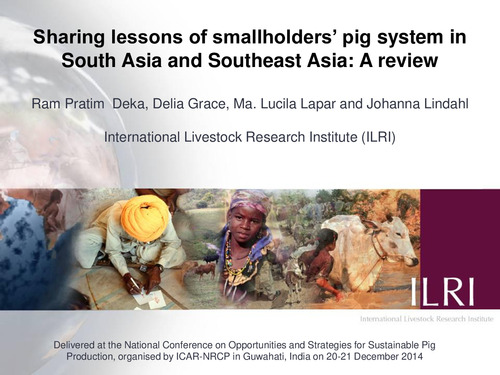Sharing lessons of smallholders’ pig system in South Asia and Southeast Asia: A review
Abstract
South Asia and Southeast (SE) Asia have some historical links from the past in respect of religion, tradition, culture, food habits, trade, language and population migration. Pig rearing is an important part of smallholders’ livelihood and socio-cultural belief among pig producers in both regions. Its distribution is largely determined by ethnicity and religion. Because of socio-religious sentiments towards pig rearing and pork consumption, pigs population in South Asia is much smaller than in SE Asia. Vietnam and the Philippines are the two major producers of pig among the SE Asian countries while India is the leading country in South Asia. The pig sub-sector in some of the countries in SE Asia is growing at a faster pace because of industrialisation of farming system and transformation of smallholder backyard system to more commercial farming system in response to market demand. Industrialisation of pig farming in South Asia is yet to take place although the transformation is going on at a slower pace. Naturally, SE Asia is endowed by a few more productive indigenous breeds compared to South Asia. Artificial insemination in pigs is more widely prevalent in SE Asia than in South Asia, although natural breeding is still predominant at smallholders’ level in both regions. Feed regime for pigs is found to be better in SE Asia than in South Asia in terms of use of more grains and protein sources. Cultivation of food-feed crops (sweet potato, maize, cassava etc.) for feeding of pigs is more popular in SE Asia than in South Asia. The housing system in both regions is in a transformation stage from scavenging to semi-intensive to intensive although the degree widely varies among the countries. There are many common diseases affecting pigs in both regions. Among these, classical swine fever (CSF) is a major disease affecting pigs in both regions. Vaccination against CSF is more common in SE Asia than in South Asia. The porcine reproductive and respiratory syndrome (PRRS) that has been posing a major threat to the pig industry in SE Asia for the last several years has just been reported recently in South Asia (NE India). Disease prevention mechanisms through vaccination and deworming are more common and widely practiced in SE Asia. Marketing system of pig/ pork in rural areas is almost the same in both regions although it is more advanced in urban centers in SE Asia. The pig subsector in SE Asia has been a prominent component of the government development policies more than it has historically been in South Asia Export market for pork is more vibrant and growing rapidly in a few countries (eg. Thailand, Vietnam) in SE Asia while this is almost nil in South Asia. Pork safety is an important issue in both regions although there are wide country variations. Overall, the pig subsector in SE Asia is more advanced in terms of wider prevalence of better breed, feed, healthcare, processing and market infrastructure including industrial farming system and export-import market than South Asia. It could be anticipated that South Asia could be benefited from some of the lessons of pig systems in SE Asia.

